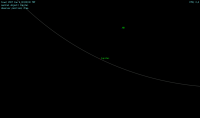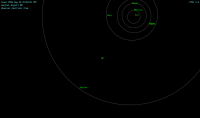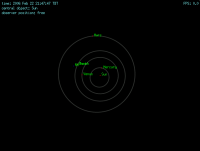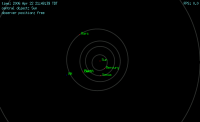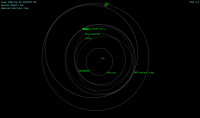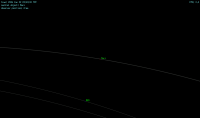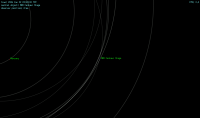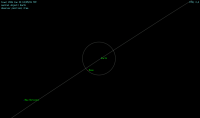Printable Version of Topic
Click here to view this topic in its original format
Unmanned Spaceflight.com _ Pluto / KBO _ New Horizons Trajectory
Posted by: hal_9000 Jan 21 2006, 06:13 PM
I can not find NH's trajectory on ssd.jpl.nasa.gov and others..
Can anyone post it here?
Thanks!!
Posted by: PhilCo126 Jan 21 2006, 08:28 PM
Well, New Horizons isn't yet included in the NASA-JPL Solar system simulator:
http://space.jpl.nasa.gov/
...
Posted by: ljk4-1 Jan 21 2006, 09:27 PM
Jonathan's Space Report
No. 560 2006 Jan 21, Somerville, MA
-------------------------------------------------------------------------------
Sender: owner-jsr@host.planet4589.org
Precedence: bulk
Reply-To: jcm@host.planet4589.org@host.planet4589.org
New Horizons
------------
The New Horizons probe to Pluto was launched at 1900:00 UTC on Jan 19
from pad 41 at Cape Canaveral by Atlas V flight AV-010.
The powerful Atlas 551 rocket, with five solid boosters, roared off the
Florida pad after two days of delays. The solids separated at 1 min 45s into
launch, arcing into the mesosphere before falling to Earth. The
5-meter-diameter fairing separated at 3min 23s, followed seconds
afterwards by the two pieces of the CFLR (Centaur Forward Load Reactor),
a contraption that connects the smaller 3.1m-diameter Centaur to the
fairing for structural stiffness. By this time Atlas was in space, with
the fairing probably reaching an apogee of 150 km or so. Atlas shut down
at 4min 27s, falling away 6s later, and the Centaur second stage ignited
at 4min 33s as the trajectory flattened out, reaching orbit insertion at
1910:08 UTC with a 167 x 213 km parking orbit. The vehicle coasted for
20 minutes and restarted over South Africa, with a 9-min burn taking the
Centaur to 800 km altitude at a velocity of 12.4 km/s, a hyperbolic
Earth orbit which will take the Centaur out to the asteroid belt. At
1939 UTC the spin-table on the forward end of the Centaur began to
rotate, and the injection stage with the payload separated. The
injection stage is an Alliant (Thiokol) Star 48B solid motor, the same
motor used on Delta 2 third stages and on the old Shuttle PAM-D flights.
Solid kick motors like to be spinning when they fire to even out any
misalignment of the thrust direction, hence the spin table - although
the Star 48B also has a set of small hydrazine rockets to correct any
unwanted nutation. After the Star 48B burn, the payload had reached
escape velocity not only with respect to the Earth but also relative to
the Sun (The velocity was 16.2 km/s relative to the Earth
and I estimate an asymptotic velocity of 12.3 km/s, corresponding to
42.6 km/s relative to the Sun and leading to a heliocentric eccentricity
of around 1.05). New Horizons separated from the Star 48B at 1944 UTC and
released two `yo-yo weights' on long wires; as NH spun around, the wires
unwound and then were released, taking angular momentum with them and
leaving the probe spinning much more slowly, around 5 rpm. NH now must
depend on its own propulsion system, four small 4.4N thrusters, to
adjust its course, with the first trajectory correction maneuvers coming
over the next several weeks.
New Horizons will fly around 2.3 million km from Jupiter on 2007 Feb 28,
and the Pluto/Charon system in 2015, with possible Kuiper Belt Object
flybys in around 2017. The probe has a dry mass of around 401 kg and a
launch mass of 478 kg (including the hydrazine course correction
propellant). It features a 2.1-m diameter high gain antenna for
communications with Earth (as well as radiometry of Pluto) and a
radioisotope thermoelectric generator (RTG) which uses the heat of 11 kg
of decaying Pu(238)O2 to provide 240 W of electrical power. This
particular model of RTG is the GPHS-RTG, also used on Cassini.
New Horizons has the following science instruments:
- Ralph, the high resolution imager, with a 0.08m telescope
and a suite of detectors: MVIC (Multispectral Visible Imaging Camera),
which has three black-and-white and four color CCD detectors, and LEISA
(Linear
Etalon Imaging Spectral Array), a 1.25-2.5 micron IR spectrometer.
MVIC should reach 0.25 km/pixel at closest approach.
- Alice, the UV spectrometer covering the 500-1800A range.
- LORRI, the long range imager with a 0.21m aperture telescope
and visible CCD detector.
- SWAP (Solar Wind at Pluto), low energy particle spectrometer
- PEPSSI (Pluto energetic particle spectrometer science investigation),
high energy ion mass/energy spectrometer
- SDC (Student Dust Counter), measuring particle impacts.
- REX (Radio experiment), using the main dish to study radio propagation
through the Plutonian atmosphere.
Stardust
---------
The Stardust probe landed successfully on Jan 15 in the highest velocity
reentry ever. The capsule has now been opened and mission scientists
report that it contains plenty of samples of comet 81P/Wild 2.
Stardust approached Earth from a 0.98 x 2.68 AU x 3.6 deg solar orbit.
Passing the Moon on Jan 14 at 1830 UTC, Stardust approached the Earth on
a 22 km perigee, 42.1 deg hyperbolic orbit. The SRC (Sample Return
Capsule) was ejected at 0557 UTC on Jan 15. At 0613 UTC Stardust fired
its engines to raise perigee to 258 km, and swung past the Earth at 1000
UTC, passing lunar orbit outbound at 0130 UTC on Jan 16. The Stardust
bus will leaving the Earth-Moon system on Jan 17 into a 0.92 x 1.70 AU x
1.9 deg orbit.
Meanwhile, the SRC reached 125 km altitude at 0957 UTC on Jan 15,
travelling almost horizontally (a flight path angle of -8.2 degrees) at
12.9 km/s. It deployed its main parachute at 1004 UTC and landed at 1010
UTC in the Utah Test and Training Range (UTTR).
This is the second spacecraft recovery from beyond lunar orbit; the first
was Genesis, which landed on 2004 Sep 8, also in the UTTR.
Erratum
-------
Oops - Parus/Tsikada and Transit operated near 0.15 GHz, not 0.15 MHz!
And Richard Langley points out to me that the Transit satellites
continued transmitting after 1996 in a non-navigation role as the Navy
Ionospheric Monitoring System. They certainly were still going strong as
late as 2001, but the web site which described the system is no longer
active; can anyone report which if any of the NIMS/Transit satellites
are still operating?
Table of Recent Launches
-----------------------
Date UT Name Launch Vehicle Site Mission INTL.
DES.
Dec 21 1838 Progress M-55 Soyuz-U Baykonur LC1/5 Cargo 47A
Dec 21 1934 Gonets-D1M ) Kosmos-3M Plesetsk LC132/1 Comms 48A
Kosmos-2416 ) Comms 48B
Dec 21 2233 Insat 4A ) Ariane 5GS Kourou ELA3 Comms 49A
MSG 2 ) Weather 49B
Dec 25 0507 Kosmos-2417 ) Proton-K/DM2 Baykonur LC81/23 Navigation 50A
Kosmos-2418 ) Navigation 50B
Kosmos-2419 ) Navigation 50C
Dec 28 0519 GIOVE A Soyuz-FG/Fregat Baykonur LC31/6 Navigation 51A
Dec 29 0228 AMC 23 Proton-M/Briz-M Baykonur LC200 Comms 52A
Jan 19 1900 New Horizons Atlas V 551 Canaveral SLC41 Pluto probe 01A
.-------------------------------------------------------------------------.
| Jonathan McDowell | phone : (617) 495-7176 |
| Somerville MA 02143 | inter : jcm@host.planet4589.org |
| USA | jcm@cfa.harvard.edu |
| |
| JSR: http://www.planet4589.org/jsr.html |
| Back issues: http://www.planet4589.org/space/jsr/back |
| Subscribe/unsub: mail majordomo@host.planet4589.org, (un)subscribe jsr |
'-------------------------------------------------------------------------'
Posted by: punkboi Jan 21 2006, 10:32 PM
http://space.jpl.nasa.gov/
...
Neither is the MESSENGER spacecraft. Perhaps JPL has something against APL missions?
Posted by: helvick Jan 21 2006, 11:00 PM
Well - that kind of answers your own question - this is an APL mission not a JPL mission so there's no compelling reason for it to be on a JPL web site.
Posted by: hal_9000 Jan 22 2006, 01:05 PM
Some datas from ssd.jpl.nasa.gov
Revised: Jan 21, 2006 New Horizons Spacecraft -98
http://pluto.jhuapl.edu/index.php
Schedule:
2006-Jan-19... launch (Atlas V551 1st stage, Centaur 2nd, STAR 48B 3rd
2007-Feb ... Jupiter gravity assist
2015-Jul ... Pluto Charon encounter
2016+ ... Kuiper Belt object encounters
Mission Objectives:
* Map surface composition of Pluto and Charon
* Characterize geology and morphology of Pluto and Charon
* Characterize the neutral atmosphere of Pluto and its escape rate
* Search for an atmosphere around Charon
* Map surface temperatures on Pluto and Charon
* Search for rings and additional satellites around Pluto
* Conduct similar investigations of one or more Kuiper Belt Objects
Spacecraft:
1025 lbs (465 kg), 8 feet wide (2.5 m), RTG powered
Post-launch trajectory:
98_pred_20060119_20060125_od003 (released 2006-Jan-20)
*******************************************************************************
*******************************************************************************
Ephemeris / PORT_LOGIN Sun Jan 22 05:05:04 2006 Pasadena, USA / Horizons
*******************************************************************************
Target body name: New Horizons Spacecraft (-98) {source: 98_pred_20060119_2006
Center body name: Sun (10) {source: DE405}
Center-site name: BODYCENTRIC
*******************************************************************************
Start time : A.D. 2006-Jan-20 00:00:00.0000 CT
Stop time : A.D. 2006-Jan-25 00:00:00.0000 CT
Step-size : 1440 minutes
*******************************************************************************
Center geodetic : 0.000000, 0.000000, 0.00000 {E-lon(deg),Lat(deg),Alt(km)}
Center cylindric: 0.00000, 0.000, 0.000 {E-lon(deg),Dxy(km),Dz(km)}
Center radii : 696000.0 x 696000.0 x 696000.0 k{Equator, meridian, pole}
System GM : 2.9591220828559093E-04 AU^3/d^2
Output units : AU-D, deg, Julian day number (Tp)
Output format : 10
Reference frame : ICRF/J2000.0
Output type : GEOMETRIC osculating elements
Coordinate systm: Ecliptic and Mean Equinox of Reference Epoch
*******************************************************************************
JDCT
OM W Tp
N MA TA
A AD PR
*******************************************************************************
$$SOE
2453755.500000000 = A.D. 2006-Jan-20 00:00:00.0000 (CT)
EC= 1.047218554066334E+00 QR= 9.840062365075131E-01 IN= 8.637488153620907E-01
OM= 1.197243484751520E+02 W = 3.598883622396694E+02 Tp= 2453755.386016075034
N = 1.036039523226175E-02 MA= 1.180918511812083E-03 TA= 1.646767917453556E-01
A =-2.083939790119697E+01 AD= 6.684586454211886E+91 PR= 1.157407291666667E+95
2453756.500000000 = A.D. 2006-Jan-21 00:00:00.0000 (CT)
EC= 1.034703732227682E+00 QR= 9.840055806051723E-01 IN= 8.604660258608851E-01
OM= 1.197223968639666E+02 W = 3.598809585157228E+02 Tp= 2453755.378474528436
N = 6.527877669034779E-03 MA= 7.321181081444460E-03 TA= 1.615135491083318E+00
A =-2.835445980707060E+01 AD= 6.684586454211886E+91 PR= 1.157407291666667E+95
2453757.500000000 = A.D. 2006-Jan-22 00:00:00.0000 (CT)
EC= 1.033619572849032E+00 QR= 9.840054836219194E-01 IN= 8.599730129954544E-01
OM= 1.197212053392239E+02 W = 3.598812906304760E+02 Tp= 2453755.377472462133
N = 6.224379773518880E-03 MA= 1.321141747506869E-02 TA= 3.054828040099436E+00
A =-2.926882765704868E+01 AD= 6.684586454211886E+91 PR= 1.157407291666667E+95
2453758.500000000 = A.D. 2006-Jan-23 00:00:00.0000 (CT)
EC= 1.033216622812397E+00 QR= 9.840054405674835E-01 IN= 8.597826670755985E-01
OM= 1.197203975997984E+02 W = 3.598816669695707E+02 Tp= 2453755.376919357106
N = 6.112811966113348E-03 MA= 1.909080472567998E-02 TA= 4.491903663153889E+00
A =-2.962388579130895E+01 AD= 6.684586454211886E+91 PR= 1.157407291666667E+95
2453759.500000000 = A.D. 2006-Jan-24 00:00:00.0000 (CT)
EC= 1.033006284284937E+00 QR= 9.840054265261474E-01 IN= 8.596827734047835E-01
OM= 1.197198120884730E+02 W = 3.598819761723426E+02 Tp= 2453755.376542187762
N = 6.054841621481327E-03 MA= 2.496688398525319E-02 TA= 5.925856385875568E+00
A =-2.981266894605479E+01 AD= 6.684586454211886E+91 PR= 1.157407291666667E+95
2453760.500000000 = A.D. 2006-Jan-25 00:00:00.0000 (CT)
EC= 1.032877115418984E+00 QR= 9.840054336563503E-01 IN= 8.596217217990696E-01
OM= 1.197193504998365E+02 W = 3.598822415259244E+02 Tp= 2453755.376259829383
N = 6.019333256683877E-03 MA= 3.084149960812402E-02 TA= 7.355907523452101E+00
A =-2.992979831461009E+01 AD= 6.684586454211886E+91 PR= 1.157407291666667E+95
$$EOE
*******************************************************************************
Posted by: hal_9000 Jan 22 2006, 09:07 PM
You can use Orsa (Orbit Reconstruction, Simulation and Analysis) simulator.
http://orsa.sourceforge.net/
Posted by: punkboi Jan 22 2006, 09:26 PM
Zuh? I didn't ask any question... Someone else brought up that JPL simulator.
And APL should have a spacecraft simulator for NH anyway...since it has one for the Messenger spacecraft.
http://messenger.jhuapl.edu/whereis/index.php
Posted by: hal_9000 Jan 23 2006, 01:27 AM
A video.
Sorry.. but i didn't have enough time for it
Posted by: icez Jan 23 2006, 01:35 PM
What are the coordinates and velocities to use with Orsa?
Posted by: djellison Jan 23 2006, 02:35 PM
You have to use Keplerian I believe, but I'm not sure as to which values count for which values within Orsa. The only other spacecraft I got working values for was Ulysses ![]()
Hal - you have a lot of very cool additions to yours ![]() Care to share an exported universe? How on earth did MRO and it's Centaur get so far apart
Care to share an exported universe? How on earth did MRO and it's Centaur get so far apart ![]()
Doug
Posted by: hal_9000 Jan 23 2006, 03:23 PM
Yeah.. you can use cartesian or keplerian modes.. but i used keplerian in that..
you can download orbital elements on ssd.jpl.nasa.gov by telnet.... ![]()
telnet ssd.jpl.nasa.gov 6775
type N* to list all spacecrafts/planets in database....
-98 is New Horizons ![]()
and MRO Centaur stage.. i don't think so that the orbit is wrong.. you need to put the spacecraft on wrong trajectory at first.. (because you have contamination risks) after it.. you need to correct spacecraft's trajectory..
Posted by: hal_9000 Jan 23 2006, 07:00 PM
Correct link -> geocities.yahoo.com.br/hydraa16/Universe.zip
select "New" ![]()
Posted by: hal_9000 Jan 23 2006, 10:56 PM
NEW LINK -> http://icez.org:81/Universe.zip
You can try to use Orsa 0.6.1.. i used it to do this file.. ![]()
That other link was flooded..
Thanks for icez! ![]()
![]()
![]()
Posted by: hal_9000 Jan 24 2006, 08:00 AM
A full animation here.. ![]()
You can play it on RealPlayer..
geocities.yahoo.com.br/hydraa16/videoNH.zip
Posted by: PhilCo126 Jan 24 2006, 07:46 PM
Thanks for pointing that link out HAL 9000 ![]()
However Realplayer needs an update to play the .ogg file ... any suggestions ?
I brought up the JPL simulator and I know it's a non-JPL mission but they (NASA) should include NH anyway ! ![]()
Posted by: hal_9000 Jan 24 2006, 09:45 PM
However Realplayer needs an update to play the .ogg file ... any suggestions ?
I brought up the JPL simulator and I know it's a non-JPL mission but they (NASA) should include NH anyway !
I uploaded it on RapidShare.de..
The link is:
http://rapidshare.de/files/11757657/NEWNEWHORIZONS.mpg.html
Posted by: hal_9000 Jan 25 2006, 12:24 AM
You can track NH s/c on Orsa 0.7.0 (at least on my nix it works..)
Here is my "universe file" MRO and NH are included... ![]()
http://rapidshare.de/files/11765507/UniversewithMRONH.zip.html
Posted by: punkboi Jan 30 2006, 06:37 PM
http://pluto.jhuapl.edu/mission/whereis_nh.php
![]()
Posted by: PhilCo126 Jan 30 2006, 08:22 PM
Still can't play the .mpg after download from Rapidshare ? ![]()
Posted by: Dave Bowman Jan 31 2006, 12:48 AM
NH Location
http://pluto.jhuapl.edu/mission/whereis_nh.php
Posted by: SpaceCat Jun 27 2008, 08:30 PM
Ultimate Trajectory Question:
Will NH leave the solar system and continue outbound as Pioneer & Voyger have--- or eventually end up in a long 'comet-type' elipse around the sun?
Posted by: ugordan Jun 27 2008, 08:31 PM
That baby's never coming back.
Posted by: Greg Hullender Jun 28 2008, 04:12 AM
Using the current positon and velocity from the "where is NH" page:
http://pluto.jhuapl.edu/mission/whereis_nh.php
And the standard gravitational parameter for the Sun, from Wikipedia
http://en.wikipedia.org/wiki/Standard_gravitational_parameter
We can figure the "hyperbolic excess" (the velocity at infinity) which I estimate at 12.7 kps.
Or, in other words, "that baby's never coming back!"
--Greg :-)
This page has some other interesting equations:
http://en.wikipedia.org/wiki/Hyperbolic_trajectory
Posted by: brellis Jun 28 2008, 04:27 AM
Questions come to my feeble mind: how does the trajectory of the Sun around the Milky Way play into the escape velocities of spacecraft like the Voyagers, Pioneers and NH? At what point would it figure into the equation?
Posted by: dmuller Jun 28 2008, 04:40 AM
No. At launch, every spacecraft already has the orbital velocity of the Sun around the Milky Way center. Similar to leaving Earth orbit: the escape speed is the same regardless of which direction (towards [like Venus Express] or away [New Horizons] from the Sun) you launch your spacecraft out of the Earth parking orbit.
However, if you want to leave the Milky Way, then it comes into play as you'd launch a spacecraft in the direction of the Sun's movement to make full use of its orbital speed. Also, if you fly in the direction of the Sun's movement, then you'll reach the bow shock and other solar system border areas sooner (because they're closer to the Sun there).
Posted by: dmuller Jun 28 2008, 04:47 AM
I have used the same wikipedia page and orbital information from the SSD Horizons System to calculate the hyperbolic excess for all 5 probes at http://www.unmannedspaceflight.com/index.php?s=&showtopic=2510&view=findpost&p=112578
16.6 km/s - Voyager 1
14.9 km/s - Voyager 2
12.5 km/s - New Horizons
11.3 km/s - Pioneer 10
10.4 km/s - Pioneer 11
Of course the value for New Horizons will change (a little) due to the Pluto flyby and KBO targeting maneuvers
Posted by: Greg Hullender Jun 28 2008, 05:55 AM
dmuller: Yikes! I'm repeating myself and doing more work the second time! :-) Getting old sucks . . . :-)
Note that the hyperbolic excess doesn't actually depend on which direction NH is going; any small body with the same speed but ANY vector would end up with the same excess (unless it hit something first). That means you can compute hyperbolic excess without knowing the semimajor axis of the hyperbola, as follows:
sqrt(v^2 - 2*mu/r)
So if you know a thing's speed and its distance from the Sun, you can compute the hyperbolic excess with no other info. Of course, if the object isn't in a hyperbolic orbit, then this'll give you an imaginary result, so you should test that v^2 > 2*mu/r -- which is the same as testing that v^2/2 > mu/r which is the same as kinetic energy > -(potential energy).
Cool stuff! :-)
--Greg
Posted by: dmuller Jun 28 2008, 07:59 AM
Well, at least you're not on the record for calling the mission "New Messenger" like I am
Posted by: Juramike Jun 28 2008, 05:09 PM
14.9 km/s - Voyager 2
12.5 km/s - New Horizons
11.3 km/s - Pioneer 10
10.4 km/s - Pioneer 11
Tougher question: Are any of these going fast enough (in the right vector) to eventually escape the Milky Way?
Posted by: Greg Hullender Jun 28 2008, 09:48 PM
I figure local escape velocity from the Milky Way at about 800 kps, assuming none of the mass of the galaxy is outside the Sun's orbit. Wikipedia says ~1000.
http://en.wikipedia.org/wiki/Escape_velocity#List_of_escape_velocities
The Sun's orbital velocity is 220 kps, so just adding 10 to 20 kps isn't anywhere near enough.
--Greg
Powered by Invision Power Board (http://www.invisionboard.com)
© Invision Power Services (http://www.invisionpower.com)

